Antique Watson & Sons Edinburgh Model C Microscope in Brass circa 1900
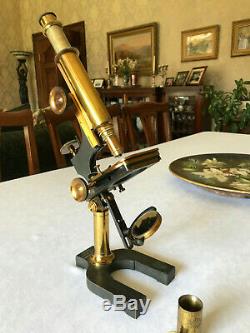

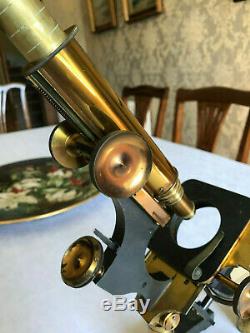
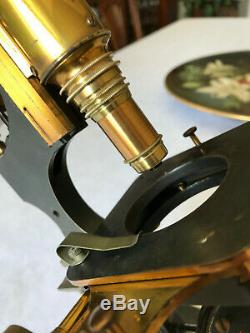
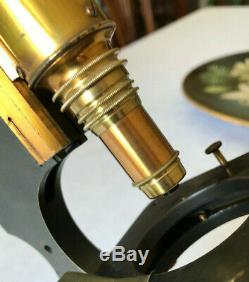
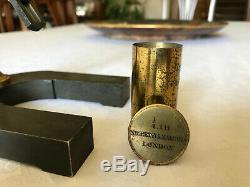


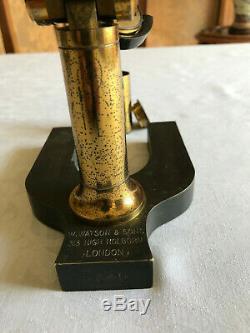
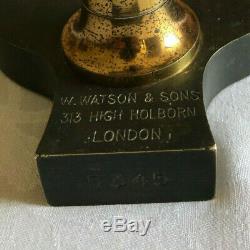
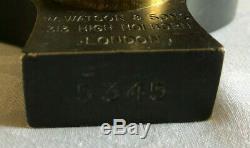


Here is a fantastic example and a rare find with an interesting configuration - a Watson & Sons Edinburgh Model "C" brass microscope. The construction is solid brass with base, post and upper all in brass. The lacquer finish is showing a nice patina and appropriate signs of age - almost glowing with a warm golden hue. This example is serial number 5345 which would date it to around the 1900 to 1901 period, so very late Victorian, or possibly very early Edwardian. This Watson Edinburgh "C" has rack and pinion main and thumb-wheel fine micrometer focusing, both of which move with the signs of wear you'd expect on an example of this period - a little stickiness but still functional.
The brass eye-piece draw-tube is also engraved with graduation markers to allow setting of the tube length. This example is fitted with an interesting and fairly high magnification set-up for the period, being a 10x Watson eyepiece and a single objective lens. The objective is interesting in that it is a period piece in brass, with very little signs of wear or tarnishing and clearly a high-quality item.
The objective itself is unmarked and it comes in a brass canister that's marked as "Negretti & Zambra, London 1/4 in". The objective fits the canister perfectly, so it appears correct. The combination of eyepiece and objective giving a magnification I would estimate in the region of 300 times based on viewing some of my prepared slides. The stage set-up is also quite interesting - it's currently part mechanical and part manual. There is a rack and pinion system that moves the y-axis smoothly. However, the x-axis rack and pinion hardware is missing, although one can see where it would have originally located. This meaning that manual x-axis movement is required and the stage has been fitted with a couple of vertically mounted thumbscrews to help the user make small manual side-to-side movements. The stage also rotates through a full 360 degrees and again manual movement is required here. The stage is also currently fitted with a single period slide-clip in brass. Below stage there is no condenser in the current configuration and lighting appears adequate using concave mirror-only illumination. There are however some mounting screws below the stage which could potentially be used to locate a condenser with a suitable mounting system.There is a plano-concave mirror which is in pretty good condition with the silvering virtually blemish-free on both sides, it's also got a height-adjustable brass support arm in addition to the usual gimbal set-up. All-in-all a really interesting example of an early Watson from the very late Victorian period in solid brass just oozing both quality and quirkiness with its current set-up. Yes there's a couple of parts absent and there's no case, but it's perfectly usable for high-magnification applications with quality optics and it's got a great period look about it. Yes, there's also evidence of wear where one would expect in the pinions, various moving parts and where the microscope has been handled over the years, so ongoing care and maintenance should be expected by any future owner in order to keep this antique Watson in tip-top condition.
Probably a good antique Watson to get started on before you succumb to more elaborate Watson models of this period like the Edinburgh "H" and Royal Van Heurck. Or, alternatively a good base for a restoration for an enthusiast to restore the missing x-axis rack and pinion and condenser - producing a much more complete and original Edinburgh Model "C". With all that brass it's a heavy piece, so will be sent by insured courier upon receipt of cleared funds. The item "Antique Watson & Sons Edinburgh Model C Microscope in Brass circa 1900" is in sale since Saturday, September 7, 2019. This item is in the category "Antiques\Science/Medicine\Scientific Instruments".The seller is "nutton0209" and is located in Glasgow. This item can be shipped to United Kingdom, Antigua and barbuda, Austria, Belgium, Bulgaria, Croatia, Cyprus, Czech republic, Denmark, Estonia, Finland, France, Germany, Greece, Hungary, Ireland, Italy, Latvia, Lithuania, Luxembourg, Malta, Netherlands, Poland, Portugal, Romania, Slovakia, Slovenia, Spain, Sweden, Australia, United States, Bahrain, Canada, Japan, New Zealand, China, Israel, Hong Kong, Norway, Indonesia, Malaysia, Mexico, Singapore, South Korea, Switzerland, Taiwan, Thailand, Bangladesh, Belize, Bermuda, Bolivia, Barbados, Brunei darussalam, Cayman islands, Dominica, Ecuador, Egypt, Guernsey, Gibraltar, Guadeloupe, Grenada, French guiana, Iceland, Jersey, Jordan, Cambodia, Saint kitts and nevis, Saint lucia, Liechtenstein, Sri lanka, Macao, Monaco, Maldives, Montserrat, Martinique, Nicaragua, Oman, Pakistan, Peru, Paraguay, Reunion, Turks and caicos islands, Aruba, Saudi arabia, South africa, United arab emirates, Ukraine, Chile, Bahamas, Colombia, Costa rica, Guatemala, Honduras, Jamaica, Kuwait, Panama, Philippines, Qatar, Trinidad and tobago, Uruguay, Viet nam.
- Period: 1800 to 1900
- Material: Brass
- Type: Microscope

